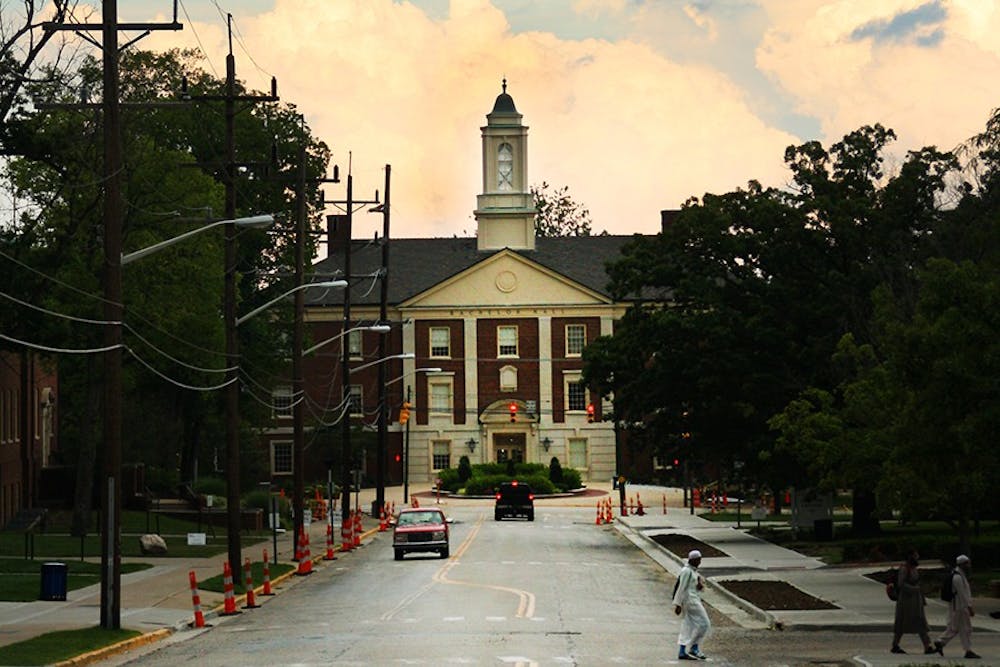By Kyle Bush, bushkt@miamioh.edu
Clemson Attaway, 20, turns his alarm off at 7:15 a.m. every Monday, Wednesday and Friday. He walks slowly to the kitchen, allowing for his muscles to wake up, and sets the coffee to brew. After a quick shower, he fills his thermos and is out the door at 7:45. Class starts at 8:30.
No, Attaway isn't allowing for 45 minutes of walk time to get to Farmers School of Business; he is actually hoping for good traffic on his way to Miami's regional campus in Hamilton. He cranks the engine of his 1996 Dodge Intrepid three times before it finally turns over, and he is off.
"That's it, that's my routine," he said. "I know it's not really the traditional Miami experience, but it's mine."
On this particular day, Attaway wears Wrangler jeans and a fleece pullover he bought from the local thrift store- not because he is trying to be fratty or hip, as many Miami students do, but because it is what he can afford.
"I have to be practical," he explained. "I don't have Daddy's credit card to buy all the Vineyard Vines and Patagonia's I want, so I work to pay for my stuff. I'm not bitter, I promise, it's just the truth."
Perhaps an unfair sentiment, it is nonetheless a perspective shared by many of the Miami students at branch campuses, who consequently lead very diverse lifestyles than the traditional Oxford campus students.
And that is what they are- individuals with diverse backgrounds, but Miami students all the same.
However, this may be changed when Miami University finalizes its plans to distance the regional campuses to decrease brand confusion. According to Journal-News, Miami University President David Hodge reiterated the University's desire to make "a series of distinctions," in a September interview.
"We've had some declining enrollment on the regional campuses, we've got some budget deficits that are growing, and we've got some outcome measures that aren't where we would like them to be," said Hodge, reportedly.
While budgets deficits are definitely understandable in light of the university's $100 million worth of construction projects this past summer, it doesn't make sense to Randy Molar, who feels regional students' statuses as Miami students is being threatened.
"I wanted a Miami degree. The split that they want seems like that's going to make it difficult for current branch kids. The whole reason I went to Miami was because it was local and because with the branch campus, I saved money and took care of the Miami Plan," said Molar, a Talawanda High School graduate and 2013 Miami alumnus. The Miami Plan refers to the curriculum plan all students are required to take before graduation, which aims to broaden student academic horizons. "I got a degree. I got a job, and I even got a wife at Miami. I want the branch kids to have those opportunities too."
Students who share Molar's sentiments should be aware of the Miami Office of Diversity Affairs (ODA), which on their website expresses a "commitment to diversity/multiculturalism as expressed through ability, age, ethnicity, gender, race, religion, sexual orientation and socioeconomic differences." The Miami regional campuses have been historically diverse, especially in the fields of age, race and socioeconomics; it can be argued, then, that further segregation of the campuses is contradictory to the ODA mission statement.
Many students, as Mallaley expressed, attend the branch campuses for monetary reasons (tuition is substantially lower at the regionals). In 2013, Miami reported that about one in every five Oxford students estimated his/her parent income at greater than $250k.
Metric 21 of Miami's 2020 Plan, which lays out university vision through 2020 and is available online, defines the goal of Global and Intercultural learning, where students will be encouraged to become, "responsible people who are attentive to diversity across the spectrum of differences."
Furthermore, Dr. Ronald B. Scott, the Associated Vice President of Institutional Diversity at Miami, referred to a part of the 2020 plan as the university's "diversity plan." He explained that each unit at Miami is expected to develop metrics in which they show progress in diversifying their recruitment and retention. "Because it's been institutionalized, and because everyone is accountable, everybody's head will roll if we do not adhere to what we say we're going to do."
"I am diverse. I am not rich. And I'm also not white," said Attaway, who is indeed African-American. "The regionals are my best shot at a Miami degree. If that gets taken away, not only are there going to be a lot of pissed off branch kids, but Miami will have hurt their own image from a diversity standpoint."
The Oxford campus actually has a higher percentage of minority students than the combined branch populations, due in large part to its successful international program. What interests Attaway, however, is the ratio of African-American students at each campus compared to other minorities.
According to Miami's website, the Asian student population in 2013 jumps from 92 at the branch campuses to 310 in Oxford, an increase of nearly 350 percent. This ratio is mirrored in the Hispanic translation, which rises from 152 to 508, again more than tripling the population. But the African-American ratio rises from 490 to 651, for an increase of just 33 percent, a stark comparison.
"I don't buy it," remarks Attaway, shaking his head slowly. As the interview closes, he stands and drains the remaining contents of his thermos, which he has refilled at the coffee shop where he works. He checks his watch- nearly 4:00 p.m. "I gotta clock in,"

